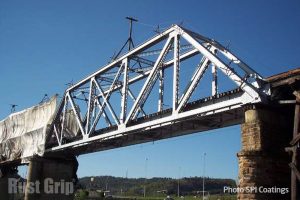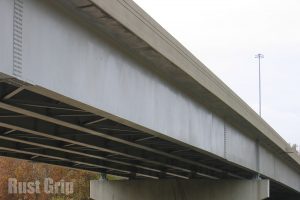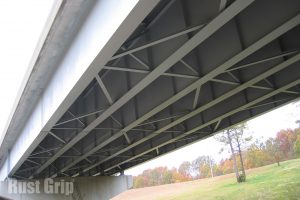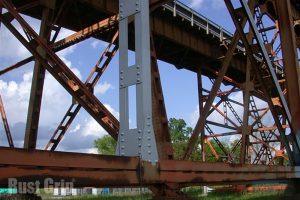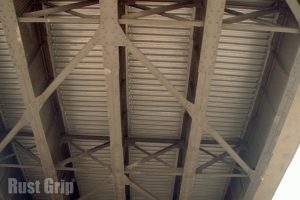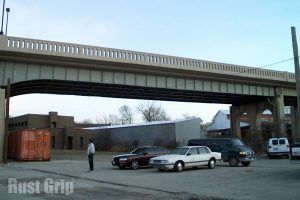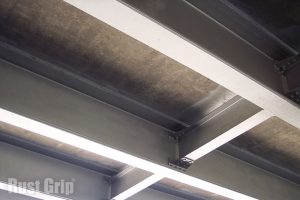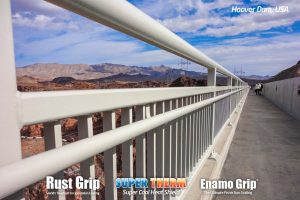Rust Grip® – The Paradigm Corrosion Coating Shift
Encapsulation of lead-based paint and existing rust with minimum surface preparation and no regulated sandblasting can save millions of dollars when transportation budgets are drastically being reduced. Allocating monies toward as many bridges as possible is the key to addressing “at risk” inventories that fall outside the established priority rankings.
By: Steve Williams – Avalotis Corporation
Avalotis Corporation is a leading industrial services provider, serving the United States, Central America and the Caribbean for more than 50 years. They’re extensive portfolio spans power, steel, food and beverage, pharmaceuticals, chip manufacturing, chemical, petrochemical, bridges, sports facilities, and historical preservation markets. Avalotis Corporation is certified by the Society for Protective Coatings (SSPC) for the QP1 and QP2 nationally recognized certification programs.
The Beginning
Rust Grip® was originally conceived and developed in 1988 by Joseph E. Pritchett, a renowned inventor of specialty industrial coatings. A new and different coating was needed to stop corrosion problems in the real world environment of the oil fields in Mexico and South America. Because of heat, humidity, and existing primitive methods of grit blasting, this coating had to have the following characteristics:
- Apply directly over surface rust;
- Apply as a one-coat system;
- Apply easily without extensive surface preparation;
- Penetrate through surface rust deep into the pores of the underlying substrate;
- Expand and swell into the pores and recesses to anchor and lock;
- Withstand abrasion and direct impact;
- Withstand acid rain and chemical splashes;
- Harden to a surface tensile strength for the petrochemical and heavy industrial areas;
- Withstand and protect from UV rays for use on the exterior of substrates;
- Possess durability and strength to last ten to twenty years in the harshest environments; and
- Use as a one part system – stir and apply.
In 1994, Joseph E. Pritchett and the company he founded, Superior Products International II, Inc., began the laboratory testing necessary to market Rust Grip®. During this testing process, the unique capabilities of Rust Grip® were revealed. The testing showed that Rust Grip® could be applied not only over surface rust, but also over existing paint with the ability to penetrate through the layers of existing paint deep into the pores of the substrate. This discovery led to the issuance of a process patent by the U.S. Patent Office on December 9, 1997, stating that Rust Grip® could be used as an encapsulant of lead-based paint, asbestos and other bio-hazardous materials. The patent (Patent #5,695,812) opened new markets for Rust Grip®, including bridges in the United States.
The capability of Rust Grip® to be applied over and to encapsulate lead-based painted surfaces or non-lead based painted surfaces has opened new avenues to protect and preserve existing bridges and other substrates at tremendous cost savings.
Dramatic Cost Reduction
Because of reduced surface preparation needed before coating, Rust Grip® can often save up to sixty percent (60%) of the total coating costs. This significant cost savings has led many states within the U.S. to begin using Rust Grip® as a coating for bridges and/or bridge repair projects. With its proven ability to be applied over existing paint and surface rust in an environmentally friendly manner, Rust Grip® will substantially reduce the cost of bridge maintenance and repair.
Deferred Maintenance Approach to Bridges
Throughout the U.S., transportation agencies are implementing bridge maintenance programs aimed at corrosion control. The direct cost of bridge corrosion is estimated to be over $8 billion annually, and the indirect cost resulting from traffic delays and lost productivity is more than 10 times that amount ($80+ billion).
Transportation agencies are not receiving adequate funds to maintain bridge inventories. With declining budgets and escalating costs, bridges continue to deteriorate, and this deterioration decreases the expected service life of these structures. Agencies must decide which bridge structures will receive funding for rehabilitation and which structures will be deferred to later years. As a result, the list of deferred bridge maintenance projects grows yearly
The future cost of addressing the structurally deficient bridge inventories has become critical because bridges compete for the same funding as other essential highway projects, such as road maintenance and new construction.
Rust Grip® – The One-coat Paint System
All polyurethanes have common elements of name and base components. With special additives, the characteristics of a base urethane can be modified to perform functions not normally expected from a basic urethane. Unlike all other moisture cure urethanes on the market (a generic category of urethanes), Rust Grip® has been developed with special additives allowing the coating to penetrate, encapsulate, and then harden. No other general category, moisture cure urethane has similar capabilities to penetrate, to anchor, and to harden or has a similar combination of functions.
Rust Grip® is formulated with a special and unique combination of solvents and additives that give Rust Grip® very high penetration / wetting / coating performance capabilities (increases pentration and adds wetting action). Rust Grip® is also very different from other urethane coatings because it is made with very high solids and very low molecular weight. Rust Grip® has performance characteristics that other urethane coatings cannot approach.
Rust Grip® is designed to be applied directly over existing flash/surface rust to provide the best profile for the coating to penetrate, encapsulate, and lock the existing rust and surface tightly. Rust Grip® penetrates deep into the pores of the existing substrate to encapsulate, then swells to anchor into the surface profile, and seals to a minimum 6,780 psi surface tensile strength (ASTM E 1795). The surface flash rust provides a profile and bond to the metal surface of the substrate that offers millions of anchors directly into the metal surface. When this profile is encapsulated and strengthen to 6,780 psi tensile strength, the coating and the metal become one unit that is tight, strong, and very secure.
Encapsulate Lead-based Paint overcoating Does Not Remove Lead Hazards
With solvent carriers that allow it to penetrate into the pores of surfaces, Rust Grip® outperforms topical surface coatings. Traditional coating systems adhere to roughness on the surface layers like a glue and are susceptible to attrition and loss of adhesion over time. Oxidation and acid rain can enter and set off corrosion, even though the surface coating remains intact.
Rust Grip® saturates deep into the pores of the metal or concrete substrate because it is made with low molecular weight solvents that act to provide wetting so that deep penetration can occur. After it penetrates, Rust Grip® draws moisture from the atmosphere which reacts with the active ingredients of the base component. This results in a gassing effect of the molecules causing them to expand and swell into all the pores to block out air, gasses, and moisture and to encapsulate the surface. After it encapsulates, Rust Grip® cures to a 6,780 psi surface tensile strength (concrete is 3,500 psi by comparison) within three (3) weeks and continues to toughen over time.
When other corrosion coatings are applied to surfaces after a completed white metal blast, corrosion redevelops after only six (6) months to two (2) years under the coating film, causing bubbles on the surface from off-gassing of the corrosion. This happens because the surface has developed flash rust before the corrosion coating was finally applied, and the coating was not designed to penetrate and encapsulate. As a result, corrosion reappears. Rust Grip® penetrates directly into and through 1/16-inch of surface rust, swells, anchors, locks, and encapsulates so that the surface cannot breathe, cannot get moisture, and cannot oxidize again. Where there is no air and moisture, there is no corrosion!
Where there is no air and moisture, there is no corrosion!
Rust Grip® will not only provide an outstanding, long-term solution against corrosion, it will tremendously reduce the impact to the environment and the exposure of workers and humans to hazardous materials such as lead-based paint.
Eliminate Sandblasting and the Adverse Impact on the Environment and Personnel
For years, sandblasting or abrasive blasting has been used to remove dirt, corrosion, and existing paint from bridges.
The dangers of abrasive blasting and other blast media practices are well documented. If abrasive blasting is performed near or over water, there can be significant adverse effects on water quality and marine inhabitants. Soil can become contaminated. Air quality can also be adversely affected if the tiny particles of blast media are discharged into the air. If the blast media is contaminated with lead, the dangers and pollution are even greater. Worker exposure to the dust generated during the blasting process is another major problem
Traditional bridge coating systems perform optimally at a SSPC-SP10 surface preparation, which requires abrasive blasting to abate the substrate and prepare surface for the new coating system. Rust Grip® performs optimally at a SSPC-SP2 surface preparation.
Steve Williams, of Avalotis Corporation, with over 20 years of experience in the paint industry, estimates that the standard, near-white metal blast produces a minimum of six (6) and up to eight (8) pounds per square foot of spent abrasive. To get a better idea of how much debris that represents, 4 million square feet of paintable surface can generate anywhere from 13,000 to 21,000 tons of spent abrasive. In contrast, the loose paint chips collected from using Rust Grip® are minimal.
Current bridge coating systems require traffic control and lane adjustments because of containment and equipment staging. Additional room is required for placement of blast pots, air compressors, dust collectors, and dumpsters. The equipment requirements for Rust Grip® are hand tools, power washers, and paint equipment – very minimal in comparison.
Eliminating the requirement for abrasive blasting dramatically reduces the environmental impact. Contaminated waste deposited in landfills, the potential for air, water, and soil contamination, and the exposure of workers and humans to hazardous substances are significantly diminished.
Economic Benefits of Using Rust Grip®
One-Coat Paint System
By replacing the traditional three-coat system with a one-coat system, Rust Grip® will save each state millions of dollars.
Rust Grip® does not require a topcoat and, therefore, is a one-coat paint system which can offer up to 60% savings on bridges and any other state-owned steel assets including guardrails, bridge and overpass railings, strain poles, and mast arms.
Rust Grip® is metallic silver/grey in colour, which is an acceptable colour for most steel structures. If a different colour is desired, the manufacturer recommends to top coat with Enamo Grip®.
Today’s maintenance budgets are underfunded and transportation agencies are unable to keep up with rising costs. Maintaining and rehabilitating bridges will inevitably become more expensive in the future, but the savings generated from decreasing product costs and manhours by eliminating two applications of paint can be used to reduce maintenance backlogs of structurally deficient bridges within state inventories.
Eliminate Sandblasting
With its ability to encapsulate lead-based paint and to be applied directly over existing paint and/or surface rust, Rust Grip® will save each state millions of dollars in surface preparation costs.
Before traditional bridge coating systems can be applied to surfaces of steel bridges, they require the substrate to be prepped to near white metal, SSPC-SP10. The prep for Rust Grip® is only a SSPC-SP2.
Abrasive blasting requires elaborate containment systems to collect abrasive dust and pulverized lead paint dust. These protective measures are labor intensive and very expensive. Containment systems are noisy and can cause environmental problems in concentrated urban areas where structures and people are in close proximity. Rust Grip® requires no elaborate protective measures or containment.
Encapsulate Lead-Based Paint
With its ability to encapsulate lead-based paint, Rust Grip® will save each state millions of dollars by eliminating the need to monitor and maintain bridges coated with the traditional overcoat method.
The traditional overcoating method is only effective if the new coating remains intact. Otherwise, the hazard of exposure to lead-based paint resurfaces. Rust Grip® penetrates and solidifies the existing layers of paint, eliminating the lead hazards once and for all. Traditional overcoating systems will not eliminate lead hazards.
There are millions of square feet of paintable steel surfaces owned by transportation agencies throughout the United States that are covered with rust and lead-based paint. Consider the savings on millions of square feet when:
- Eliminating the manhours and product costs associated with the application of two additional coatings (the intermediate and finish coat as prescribed in a traditional 3-coat system);
- Eliminating the manhours and equipment costs associated with prepping the surface to a SSPC-SP10 versus a SSPC-SP2 surface preparation;
- Decreasing the costs associated with the containment and disposal of non-hazardous and hazardous/special waste from abrasive blasting.
The savings generated from using Rust Grip® versus the traditional bridge coating systems are tremendous. Given these savings, Rust Grip® must be considered for use by all transportation agency bridge maintenance programs.
Field Tested and Laboratory Proven
Tests for Rust Grip® conducted by accredited laboratories demonstrate:
- Rust Grip® can encapsulate and penetrate up to 18 layers of existing lead-based paint
- Rust Grip® hardens to 6,780 psi surface tensile strength after curing for three (3) weeks
- Rust Grip® is an approved lead-based paint abatement method
- Rust Grip® is chemical and acid resistant.
Field testing conducted by a NACE certified independent inspector/consultant:
Rust Grip® has tested with several state Department of Transportations and proven its ability to encapsulate and penetrate existing red lead. In one state test, the existing red lead paint had 100 psi pull test strength, but after Rust Grip® encapsulation, the pull test strength on the same painted surface was 580 psi. No other coating on the market has shown these results in either laboratory or actual field testing.
Additional testing includes:
ASTM Testing:
B117/D1654, D610-01, D714-02, D1654-05 D3359, D4060, D4541, E903-96, E1795, G20-88, G85
China Shipbuilding Tests:
- GB/T 1771-91 Salt Fog Resistance (2000 Hrs)
- GB/T 1866-88 Manual Aging (2000 Hrs)
- GB/T 10834-88 Salt Water Resistance (1000 Hrs)
- GB/T 5219-85 Pulling Apart Adhesion (4.07 MPa)
- GB/T 1733-93 Boiling Water Immersion (8 hrs)
Maritime Approvals:
- DNV (Det Norske Veritas)
- Certified ABS (American Bureau of Shipping)
- Certified US Coast Guard – Certified
- Certified IMO (Internat’l Marine Organization)
Conclusion
Corrosion of steel bridges has been a problem for hundreds of years, and little progress has been made over the last 30 years with traditional coating systems to address the issue. Maintenance painting and lead-based paint removal are being placed in a backlog year after year as transportation agencies contend with budget shortfalls and an increasingly aging infrastructure. The key to reducing structurally deficient bridge inventories is for transportation agencies to find new and innovative ways to stretch their budget dollars. The pressure to find necessary funding to address these known “risk” bridge inventories is tremendous.
Encapsulation of exising rust with minimum surface preparation and elimination of regulated, abrasive blasting can save critical time and money. Set up times, project duration, traffic interference, liability costs for worker protection, and public and environmental issues are all dramatically reduced by using minimum surface preparation and coating with Rust Grip®.
Any coating system (Rust Grip®) that:
- is easy-to-prep and easy-to-apply while at the same time extending service life
- encapsulates and seals lead-based paint
- attains higher pull-off strength than current bridge coating systems
- withstands extreme temperatures and harsh chemical or salt environments, and
- can be applied for 60% less than the total cost of traditional coating systems is a solution that demands serious consideration.
Rust Grip® has passed all of the testing dictated by the current coating system requirements, including emersion testing (ASTM G 20) which most traditional coating systems cannot pass.
The transportation and bridge infrastructure in the U.S. is in dire need of maintenance and repair. Rust Grip® can be the answer to stop corrosion and to increase service life in a cost effective and environmentally friendly manner. Moreover, Rust Grip® has the performance history, testing, and credentials to satisfy even the staunchest critic and to resolve all doubts in favour of positive action. The time is now, and the only rational decision is Rust Grip®.
Source: Silo Tips




